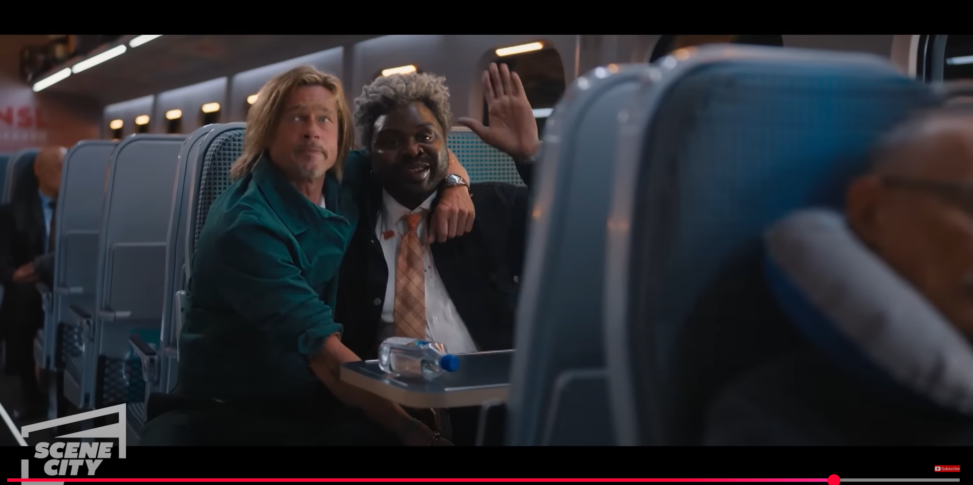So, I just watched Bullet Train (2022), directed by David Leitch, and let me tell you it’s like if a comic book exploded into an action movie, with assassins, dark humor, and a fight over a briefcase that’s way too important. The film throws you onto a high speed bullet train in Japan, where chaos and combat unfold in the most absurdly entertaining ways. One of the standout moments? The fight scene between Ladybug (Brad Pitt) and Lemon (Brian Tyree Henry). Let’s dive into details.
Imagine two mature men arguing over a piece of luggage on a smooth, contemporary, and serene train. That’s the contrast at play here. Ladybug, rocking his relaxed blue green jacket, seems like he wants no part in this mess. Lemon, on the other hand, is fully in the game, his bloodstained shirt and loosened tie screaming, I’ve had a long day, and it’s not getting any better. The camera captures this all with a slight tilt and motion blur, emphasizing the train’s speed and the fight’s chaos. What makes this fight unique is how tight the space is. There’s no room for fancy footwork or wide punches. Instead, they use what they can like seatbacks, tray tables, even unsuspecting passengers (well, almost). It’s an action sequence that forces creativity, much like Jackie Chan’s signature fights where everyday objects become weapons of necessity.
The way this scene is shot? Pure adrenaline. Handheld cameras, quick cuts, and close-ups put you in the mix. Blink and you might miss something. I counted (okay, guessed) at least 50 cuts in a minute. It’s fast, but never confusing. The 180-degree rule keeps everything spatially coherent, so you always know who’s punching who.
One of the best tricks the film pulls is match on an action editing. When Ladybug swings a laptop at Lemon’s head, the next shot aligns perfectly with Lemon recoiling so smooth, you’d swear you felt the impact. And then there’s slow motion. When the briefcase starts slipping from Lemon’s grasp, time slows down just enough to make you laugh before snapping back to chaos. It’s action and comedy rolled into one.
Now, Bullet Train isn’t intense action film. However, it’s violent for sure, but in a way that almost feels playful. The punches land, but they come with witty one-liners that make you chuckle instead of wince. It’s like watching a dramatic choreography where people get smacked with laptops instead of twisting. Representation wise, the film gives us a diverse cast without making it a big deal. Ladybug is the reluctant fighter, while Lemon is all in. The film doesn’t preach, but it subtly plays with action movie tropes different fighting styles, different personalities, but all equally capable of throwing a punch (or dodging one).
Action movies, especially ones as stylized as Bullet Train, play a fascinating role in how we view violence. According to Hazlett and Mag Uidhir (2011), audiences can tell the difference between cinematic violence and real aggression because films exaggerate everything. Meanwhile, Feasey (2022) argues that comedic violence, like the fights in Bullet Train, makes it easier for audiences to digest the brutality. Grodal (2005) adds that rapid editing and dynamic camera work boost emotional engagement, making scenes like this even more thrilling.
Did people love Bullet Train? The numbers say yes. It pulled in over $239 million worldwide (Box Office Mojo, 2022), and a huge part of that success came from its mix of humor, action, and Brad Pitt doing what he does best being effortlessly cool while getting punched in the face.
Do action movies make people violent? That’s a debate that never ends. Researchers like Ferguson (2015), argue that people know the difference between fiction and reality. Given Bullet Train’s over the top style, it’s unlikely anyone’s walking out of the theater thinking, I should hit someone with a laptop. It’s more about entertainment than instigating real world aggression.
At the end of the day, Bullet Train’s briefcase fight is a masterclass in action comedy. It’s frantic but controlled, brutal but hilarious, and stylish without taking itself too seriously. It’s proof that modern action sequences can be as much about fun as they are about fists flying. And really, isn’t that what we’re all here for?
Sources:
Hazlett, Allan, and Christy Mag Uidhir. “Unrealistic fictions.” American Philosophical Quarterly 48, no. 1 (2011): 33-46.
Feasey, Rebecca. “From The One to John Wick: Keanu Reeves and the Action Genre.” In Gender and Action Films 1980-2000, pp. 199-212. Emerald Publishing Limited, 2022.
Grodal, Torben. “Film lighting and mood.” Moving Image Theory: Ecological Considerations (2005): 152.
Ferguson, Christopher J. “Blazing angels or resident evil? Can violent video games be a force for good?” Review of General Psychology 19, no. 2 (2015): 130-144.


Diya Rai
Khagendra’s analysis of the fight scene between Ladybug and Lemon in Bullet Train is detailed and engaging. Khagendra does a great job at describing the setting of the scene, which includes the tight space of the train and also goes into detail of how the characters use everyday items like seatbacks and tray tables in their fight, which makes the scene stand out. The comparison to Jackie Chan’s style highlights the creative and fun approach to action. Khagendra also explains the different film techniques used in the movie, such as handheld cameras, quick cuts, and the 180-degree rule, that enhance the viewer’s experience. The student also mentioned that the match on editing and slow motion scenes adds to understanding how the scene mixes action with humour. This analysis includes good scholarly ideas that support what the student is saying, and the scholarly sources also broadened the conversation. The student’s chosen image also fits well and matches the moment they are talking about. Overall, Khagendra’s thoughtful and well-supported analysis gives a well-rounded look at the scene.